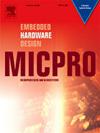基于dsl的SNN加速器的Chisel设计
IF 2.6
4区 计算机科学
Q3 COMPUTER SCIENCE, HARDWARE & ARCHITECTURE
引用次数: 0
摘要
神经网络是一个非常活跃的研究领域,在工业上也有广泛的应用。尖峰神经网络(snn)是一种新兴的神经网络,有望实现硬件加速和低能量需求。但是在加速器电路生成方面的设计自动化仍然缺乏合适的搜索技术来优化网络参数,包括选择合适的神经元模型和尖峰编码。它们通常仅限于实现单一的网络设置和/或固定的硬件体系结构。在本文中,我们提出了一种新的多层领域特定语言(DSL),用于构建顺序电路,包括支持危险检测的管道构建块。我们使用Chisel作为宿主语言,这是一种硬件构造语言,允许在寄存器-传输级及以上级别表示硬件。与应用高级合成相比,我们通过定义SNN的构建块,为基于Chisel的SNN加速器设计引入了一种领域特定语言(DSL)。在介绍了这个DSL之后,我们提出了一个完整的SNN加速器生成框架,涵盖了从培训到部署的所有阶段。还提出了使用不同神经元模型、参数化和尖峰编码的各种SNN加速器设计的设计空间探索。当将生成的设计映射到用于MNIST、Fashion-MNIST、SVHN和CIFAR-10数据集的现场可编程门阵列(fpga)时,将根据执行时间、功耗、分类准确性和资源使用情况对其进行评估。本文章由计算机程序翻译,如有差异,请以英文原文为准。
DSL-based SNN accelerator design using Chisel
Neural Networks (NNs) are a very active field of research that also has wide-ranging applications in industry. An emerging type of NN that is promising for hardware acceleration and low energy requirements are Spiking Neural Networks (SNNs). But design automation in terms of accelerator circuit generation is still lacking proper search techniques for optimization of network parameters including the selection of proper neuron models and spike encodings. They are often restricted to implement a single network setting and/or a fixed hardware architecture.
In this paper, we present a novel multi-layer Domain-Specific Language (DSL) for constructing sequential circuits, including building blocks for pipelines supporting hazard detection. As the host language, we use Chisel, a hardware construction language allowing to express hardware at Register-Transfer Level and above. In contrast to applying High-Level Synthesis, we introduce a domain-specific language (DSL) for SNN accelerator design based on Chisel by defining building blocks for SNNs. After introducing this DSL, we present a full SNN accelerator generation framework that covers all phases, from training to deployment. Also proposed is a design space exploration for various SNN accelerator designs using different neuron models, their parametrizations as well as spike encodings. The generated designs are evaluated in terms of execution time, power consumption, classification accuracy, and resource usage when mapped to Field-Programmable Gate Arrays (FPGAs) for the MNIST, Fashion-MNIST, SVHN, and CIFAR-10 data sets.
求助全文
通过发布文献求助,成功后即可免费获取论文全文。
去求助
来源期刊

Microprocessors and Microsystems
工程技术-工程:电子与电气
CiteScore
6.90
自引率
3.80%
发文量
204
审稿时长
172 days
期刊介绍:
Microprocessors and Microsystems: Embedded Hardware Design (MICPRO) is a journal covering all design and architectural aspects related to embedded systems hardware. This includes different embedded system hardware platforms ranging from custom hardware via reconfigurable systems and application specific processors to general purpose embedded processors. Special emphasis is put on novel complex embedded architectures, such as systems on chip (SoC), systems on a programmable/reconfigurable chip (SoPC) and multi-processor systems on a chip (MPSoC), as well as, their memory and communication methods and structures, such as network-on-chip (NoC).
Design automation of such systems including methodologies, techniques, flows and tools for their design, as well as, novel designs of hardware components fall within the scope of this journal. Novel cyber-physical applications that use embedded systems are also central in this journal. While software is not in the main focus of this journal, methods of hardware/software co-design, as well as, application restructuring and mapping to embedded hardware platforms, that consider interplay between software and hardware components with emphasis on hardware, are also in the journal scope.
 求助内容:
求助内容: 应助结果提醒方式:
应助结果提醒方式:


